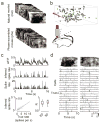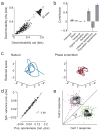Population code in mouse V1 facilitates readout of natural scenes through increased sparseness
- PMID: 24747577
- PMCID: PMC4106281
- DOI: 10.1038/nn.3707
Population code in mouse V1 facilitates readout of natural scenes through increased sparseness
Abstract
Neural codes are believed to have adapted to the statistical properties of the natural environment. However, the principles that govern the organization of ensemble activity in the visual cortex during natural visual input are unknown. We recorded populations of up to 500 neurons in the mouse primary visual cortex and characterized the structure of their activity, comparing responses to natural movies with those to control stimuli. We found that higher order correlations in natural scenes induced a sparser code, in which information is encoded by reliable activation of a smaller set of neurons and can be read out more easily. This computationally advantageous encoding for natural scenes was state-dependent and apparent only in anesthetized and active awake animals, but not during quiet wakefulness. Our results argue for a functional benefit of sparsification that could be a general principle governing the structure of the population activity throughout cortical microcircuits.
Figures






References
-
- Attneave F. Some informational aspects of visual perception. Psychol Rev. 1954;61:183. - PubMed
-
- Barlow HB. The coding of sensory messages. Curr Probl Anim Behav. 1961:331–360.
-
- Simoncelli EP, Olshausen BA. Natural image statistics and neural representation. Annu Rev Neurosci. 2001;24:1193–1216. - PubMed
-
- Olshausen BA, Field DJ. Emergence of simple-cell receptive field properties by learning a sparse code for natural images. Nature. 1996;381:607–609. - PubMed
Publication types
MeSH terms
Grants and funding
LinkOut - more resources
Full Text Sources
Other Literature Sources
Molecular Biology Databases

